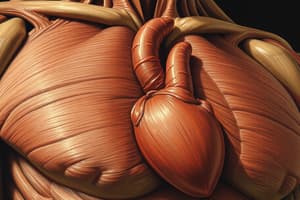Podcast
Questions and Answers
Which property of muscles refers to their ability to return to original shape after being stretched?
Which property of muscles refers to their ability to return to original shape after being stretched?
- Contraction
- Excitability
- Extensibility
- Elasticity (correct)
Which muscle type is characterized by being multinucleated and involved in voluntary movement?
Which muscle type is characterized by being multinucleated and involved in voluntary movement?
- Skeletal muscle (correct)
- Cardiac muscle
- Connective muscle
- Smooth muscle
What is the primary function of cardiac muscle?
What is the primary function of cardiac muscle?
- Support voluntary movement
- Move the skeleton
- Pump blood around the body (correct)
- Facilitate digestion
Which of the following characteristics applies to smooth muscle?
Which of the following characteristics applies to smooth muscle?
What connects cardiac muscle cells together for better communication?
What connects cardiac muscle cells together for better communication?
Which function of muscle is primarily involved in maintaining body temperature?
Which function of muscle is primarily involved in maintaining body temperature?
What property of muscle tissue allows it to respond to a stimulus from a motor neuron?
What property of muscle tissue allows it to respond to a stimulus from a motor neuron?
Which property of muscle is defined as its ability to be forcibly shortened?
Which property of muscle is defined as its ability to be forcibly shortened?
What does the extensibility property of muscle tissue allow it to do?
What does the extensibility property of muscle tissue allow it to do?
Which muscle function is involved in both the digestive and respiratory systems?
Which muscle function is involved in both the digestive and respiratory systems?
Flashcards are hidden until you start studying
Study Notes
Properties of Muscle Tissues
- Contraction: Muscle can shorten
- Elasticity: Muscle can return to its original length after being stretched
- Excitability: Muscle can respond to stimulus
- Extensibility: Muscle can be stretched
Classification of Muscle Tissues
- Skeletal Muscle: Involved in voluntary movement
- Characterisitics:
- Long, cylindrical, unbranched
- Multinucleated
- Attached to skeleton
- Actin and Myosin proteins
- Contains sarcomeres (involved in contraction)
- Characterisitics:
- Cardiac Muscle: Involuntary (has own pacemaker)
- Characteristics:
- Branched and cylindrical
- Striated
- Uninucleated
- Function: Pumps blood around the body
- Connections:
- Intercalated discs: hold cells together
- Gap junctions: allow communication
- Characteristics:
- Smooth Muscle: Involuntary
- Characteristics:
- Unbranched
- Spindle-shaped
- Uninucleated cells
- Location: Renal, respiratory tract, and blood vessels
- Function: Helps push substances in the body
- Structure: Cells are not arranged in the same direction (unlike cardiac and skeletal)
- Characteristics:
Functions of the Muscle
- Circulation
- Movement
- Digestion
- Stability
- Urination
- Respiration
- Heat production / regulation: Muscle contraction produces heat to maintain body temperature
Properties of Muscle Tissue
- Excitability: Ability to respond to a stimulus
- Contractility: Ability to shorten
- Extensibility: Ability to stretch
- Elasticity: Ability to recoil to its original length
Studying That Suits You
Use AI to generate personalized quizzes and flashcards to suit your learning preferences.



